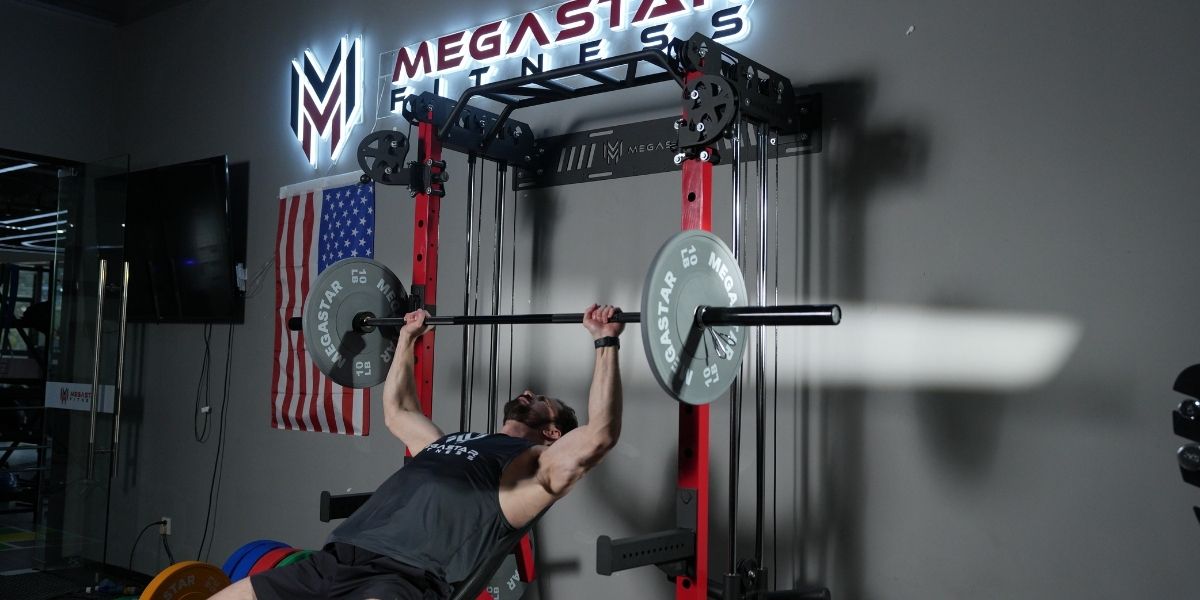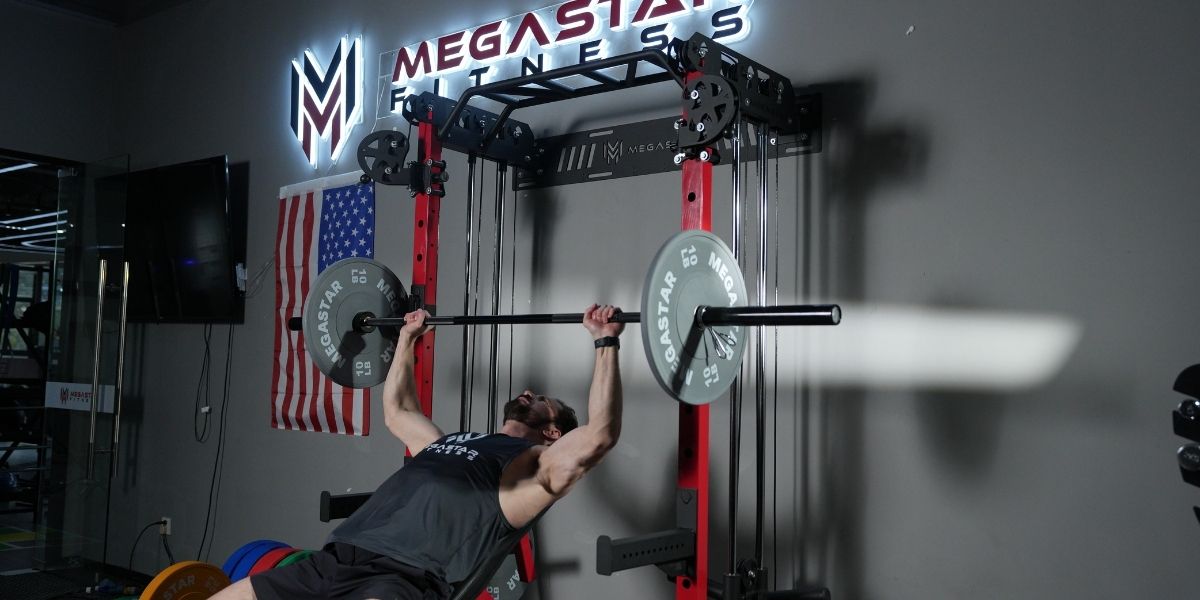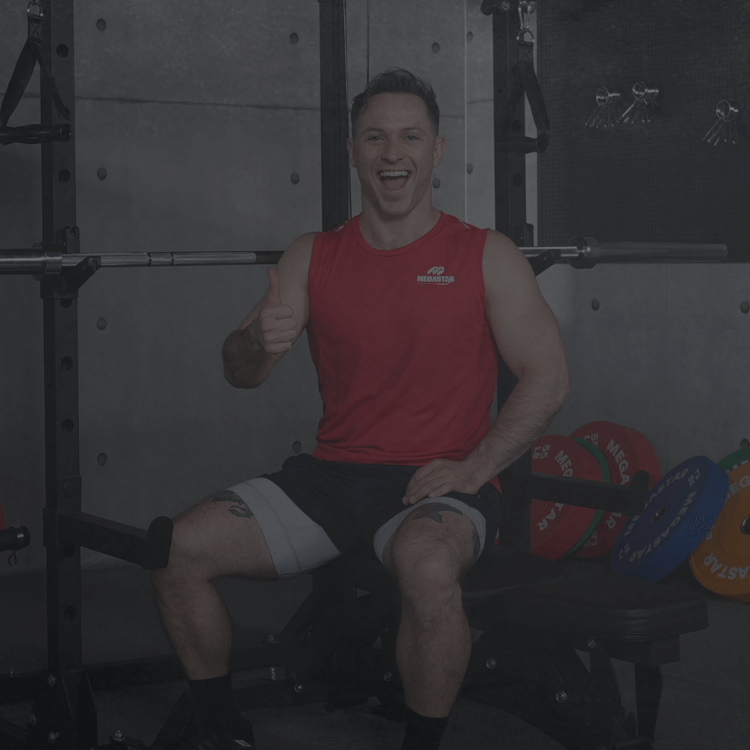You want stronger legs, chest, shoulders, and glutes, but free-weight form still feels shaky, or your gym is packed and the racks are taken. The Smith machine can reduce noise: its fixed bar path helps you learn positions, target specific muscles, and incorporate smart progression without second-guessing balance. This guide shows you exactly how to set up, what to feel, how to scale load week to week, and two simple ways to “amp up” each move for better results.
What Is a Smith Machine?
A Smith machine is a weight training machine featuring a barbell fixed within steel rails, allowing only vertical or nearly vertical movement. This fixed bar path offers incredible stability, allowing you to focus purely on the target muscle while reducing the need for your body's smaller stabilizer muscles to work.
You might choose it over free weights when:
- The gym is crowded, and all the squat racks are taken.
- You're learning a new movement pattern and want to nail the form without worrying about balance.
- You're training solo and want to push yourself on heavy lifts safely.
Using a Smith Machine Safely
Before you start, run through this quick safety check. It takes 30 seconds and ensures a better, safer lift.
Fast Safety Checklist
- Set safeties just below your bottom position for the day’s lift.
- Align the bar’s travel with your joints (mid-foot for squats, lower-mid chest touch point for bench, clavicle line for overhead, hip crease for thrusts).
- Keep wrists neutral and stacked over elbows; brace your core before each rep.
- Start a new movement with lighter weight to confirm pain-free range of motion.

Benefits of Using a Smith Machine
Using a Smith machine isn't "cheating"—it's strategic. Here are four key benefits:
Confidence when training alone: You can re-rack with a quick wrist turn and rely on safeties.
Consistent technique: Fixed path makes it easier to groove depth, bar touch points, and lockout.
Hypertrophy leverage: Tempos, pauses, and partials are simpler to execute and recover from.
Joint-friendly options: Foot placement and bench angles are easy to repeat and adjust.
The Four Moves to Amp Up
Here’s how to take four classic lifts to the next level using the Smith machine. Each one follows a simple, repeatable format.
Smith Squat
The Smith machine squat is excellent for targeting your quads and glutes with a ton of stability.
- Setup: Place your feet slightly forward of the bar, about shoulder-width apart, with your toes pointed slightly out. Set the safety stoppers to just below where the bar would be if your thighs were parallel to the floor.
- Cues: Before you un-rack, take a deep breath and brace your core. Initiate the movement with a small hip hinge (push your butt back slightly), then think about "sitting down" between your heels. Drive through the middle of your foot to stand back up.
- Load & Progression: Start with a weight you can comfortably perform for 8–10 smooth reps. If all reps are clean and you feel you have 1-2 more in the tank, add a small amount of weight (like 2.5–5 lbs) in your next session.
- Two Ways to Amp Up:
3-Second Lowers: Control the descent by counting to three on the way down. This increases time under tension, a key driver of muscle growth.
1.5-Rep Squats: Go all the way down, come halfway up, go back down, and then stand all the way up. That’s one rep. This overloads the bottom portion of the squat.
- Mistakes to Avoid: Don't let your heels pop up off the floor. Avoid letting your knees cave inward. Keep your core braced throughout the entire set to protect your lower back.
Smith Bench Press
This move isolates the chest, shoulders, and triceps without requiring you to stabilize the bar.
- Setup: Position a flat bench so the bar touches your lower to mid-chest at the bottom of the movement. Set the safeties a finger-width below that touch point.
- Cues: Grip the bar with your wrists stacked directly over your elbows. Squeeze your shoulder blades together and tuck them "into your back pockets." It’s okay to have a slight arch in your lower back, but keep your ribs down and glutes on the bench.
- Load & Progression: Choose a weight that leaves you with 1–2 reps in reserve (RIR) at the end of your set. If the bar speed stays fast and consistent on your last rep, add a small amount of weight next time.
- Two Ways to Amp Up:
2-Second Pause on Chest: Bring the bar down to your chest and hold it there for a full two seconds before pressing up. This eliminates momentum and makes the press much harder.
Rest-Pause Finisher: On your last set, do as many reps as you can (e.g., 8), re-rack the weight, rest for 15 deep breaths, then go again for as many reps as you can (e.g., 3). Repeat one more time. This is a brutal but effective intensity technique.
- Mistakes to Avoid: Avoid flaring your elbows out to 90 degrees; keep them tucked at around a 45–75 degree angle. Don't bounce the bar off your chest to generate momentum.

Smith Overhead or High-Incline Press
Perfect for building boulder shoulders with added stability to protect your lower back. This works well on a high incline (75 degrees) or fully upright (85−90 degrees).
- Setup: Adjust an adjustable bench to a high incline (75–85 degrees). The bar should start and finish along your clavicle (collarbone) path.
- Cues: Keep your ribs down to prevent your lower back from arching excessively. Squeeze your glutes and press your feet into the floor. As you press up, think about pushing your head "through the window" you create with your arms at the top.
- Load & Progression: Use a moderate weight for 6–10 reps. This exercise is often hard to progress, so focus on micro-loading (adding very small amounts of weight) as your lockout strength improves.
- Two Ways to Amp Up:
Slow Eccentrics: Lower the bar slowly over 3–4 seconds. This builds shoulder stability and control.
Top-Half Partials: After your main set, reduce the weight slightly and perform reps only in the top half of the movement to strengthen your lockout.
- Mistakes to Avoid: The most significant error is over-arching the lower back to turn the lift into an incline press. Also, avoid shrugging your shoulders up toward your ears; keep them down and back.
Smith Hip Thrust
This is one of the best exercises for targeting the glutes, and the Smith machine makes it easy to load weights safely and effectively.
- Setup: Place your upper back across the edge of a bench. Use a bar pad to protect your hips. At the top of the movement, your shins should be vertical.
- Cues: Before you lift, tuck your tailbone under slightly (a posterior pelvic tilt). Drive through your heels and squeeze your glutes as hard as you can at the lockout position at the top.
- Load & Progression: Add weight only when you can hold a solid 2-second top squeeze for all reps in your set with perfect form.
- Two Ways to Amp Up:
2–3 Second Isometric Holds: Hold the top, squeezed position for a full 2–3 seconds on every single rep.
Constant-Tension Sets: Don't let the weight rest at the bottom. Just tap the plates to the ground (or stop just short) and immediately drive back up, keeping the tension on your glutes the entire time.
- Mistakes to Avoid: Don't hyperextend your low back at the top; the movement should come from your glutes. Keep your chin tucked and your ribcage down to avoid this.
Ready to Find Your Perfect Smith Machine?

Experiencing the benefits of a Smith machine firsthand is a game-changer, and having one in your own home gym offers the ultimate convenience for safe, solo training. If you're ready to invest in a piece of equipment that provides incredible versatility, Megastar Fitness offers a fantastic collection to explore. We have everything from compact, space-saving models like the MEGASTAR P70 Half Rack perfect for a garage gym, to robust all-in-one systems like the MEGASTAR P107 Smith Machine, which includes a dual pulley system for a complete full-body workout. Built with commercial-grade steel and smooth linear bearings, their machines are designed for stability and durability, allowing you to focus on what matters most—building strength with confidence.
FAQs
Is the Smith machine good for beginners?
Absolutely. It's a fantastic tool for beginners to learn movement patterns like the squat and bench press without the intimidation or instability of a free barbell.
How should I set the safeties for each lift?
Set them just below the lowest point of your range of motion. For squats, that’s just below parallel. For bench press, it's about an inch off your chest. This way, if you fail, you can safely rest the bar.
Does the fixed path make squats “bad for knees”?
Not necessarily. The key is proper setup. Placing your feet slightly forward allows your hips and knees to bend naturally. If you experience knee pain, adjust your foot position or check your depth. For most people, it's perfectly safe.
Can I build muscle as effectively as with free weights?
Yes. For hypertrophy (muscle growth), the key is mechanical tension. The Smith machine allows you to apply a huge amount of tension directly to the target muscle with great stability, making it an excellent muscle-building tool.
Conclusion
The Smith machine isn't better or worse than free weights; it's a different tool with unique advantages. It makes progression straightforward, allows for safe solo training, and unlocks powerful techniques like tempo work and pauses. Instead of walking past it, use it strategically to amp up your workouts.
Your next step? Pick one of the "amp up" techniques from this guide and try it during your next workout this week. You might be surprised at how challenging and effective it is.







